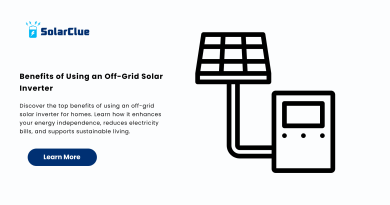Step by Step Guide Applying for Solar Subsidy in 2024
India has been making significant strides in promoting solar energy through various initiatives and subsidies. The PM Surya Ghar Muft Bijli Yojana is one such program aimed at encouraging residential solar rooftop installations. This blog provides detailed information on the eligibility criteria, necessary documents, and the application process for availing Solar Subsidy 2024. It also covers the role of state governments and DISCOMs, common challenges faced by applicants, and tips for a successful application.
Table of Contents
- 1 Eligibility Criteria for Solar Subsidies
- 1.1 Required Documents for Subsidy Application
- 1.2 Step-by-Step Application Process
- 1.3 Different Types of Solar Subsidies Available
- 1.4 Benefits of Availing Solar Subsidies
- 1.5 Role of State Governments and DISCOMs
- 1.6 Common Challenges and How to Overcome Them
- 1.7 Tips for a Successful Subsidy Application
- 1.8 Post-Subsidy Process: Installation and Net Metering
- 1.9 Additional Incentives and Benefits for Solar Rooftop Owners
- 1.10 The Future of Solar Subsidies in India
- 1.11 FAQs
Eligibility Criteria for Solar Subsidies
To be eligible for solar subsidies under the PM Surya Ghar Muft Bijli Yojana, applicants must meet the following criteria:
- Residential Status: The applicant must be a resident of India and the property must be a residential one.
- Property Ownership: The applicant must own the property where the solar panels will be installed.
- Technical Specifications: The solar panels and installation must meet the technical specifications outlined by the Ministry of New and Renewable Energy (MNRE).
Required Documents for Subsidy Application
Applicants need to submit the following documents when applying for the solar subsidy:
- Identity Proof: Aadhar Card, PAN Card, or Passport
- Property Ownership Proof: Property tax receipt, sale deed, or electricity bill
- Bank Details: Cancelled cheque or bank passbook copy
- Technical Details: Details of the solar system, including capacity, type, and installation plan
- Quotation from a Registered Vendor: A detailed quotation from an MNRE-approved vendor
Step-by-Step Application Process
- Research and Choose a Vendor: Select an MNRE-approved vendor for your solar installation.
- Site Assessment: Have the vendor conduct a site assessment to determine the feasibility and optimal configuration.
- Obtain a Quotation: Get a detailed quotation from the vendor, including the system design, capacity, and costs.
- Fill Out the Application Form: Complete the subsidy application form available on the MNRE or state government website.
- Attach Required Documents: Gather and attach all necessary documents as listed above.
- Submit the Application: Submit the application form and documents to the local DISCOM or through the online portal.
- Application Review: The DISCOM will review the application and conduct a site inspection.
- Approval and Installation: Upon approval, proceed with the installation of the solar system.
- Inspection and Commissioning: After installation, the DISCOM will inspect and commission the system.
- Receive Subsidy: The subsidy amount will be disbursed directly to your bank account or adjusted in your electricity bill.
Different Types of Solar Subsidies Available
- Central Financial Assistance (CFA): Provided by the MNRE, covering up to 40% of the installation cost for systems up to 3 kW.
- State Subsidies: Additional subsidies offered by state governments, varying by region.
- DISCOM Subsidies: Some DISCOMs provide further incentives and rebates on solar installations.
Benefits of Availing Solar Subsidies
- Cost Reduction: Significant reduction in the upfront cost of solar installation.
- Faster ROI: Accelerates the return on investment by lowering initial expenses.
- Environmental Impact: Encourages the use of clean energy, reducing carbon footprint.
- Energy Independence: Reduces dependence on grid electricity and ensures a reliable power supply.
Role of State Governments and DISCOMs
State governments and DISCOMs play a crucial role in the implementation and administration of solar subsidies:
- State Governments: Provide additional subsidies, streamline application processes, and promote awareness.
- DISCOMs: Review applications, conduct site inspections, and facilitate net metering arrangements.
Common Challenges and How to Overcome Them
- Lengthy Approval Process: Delays in application review and site inspections can be minimized by regularly following up with DISCOMs.
- Document Discrepancies: Ensure all documents are complete and accurate before submission.
- Vendor Issues: Choose reputable MNRE-approved vendors to avoid installation and service issues.
Tips for a Successful Subsidy Application
- Thorough Research: Understand the eligibility criteria, required documents, and the application process thoroughly.
- Accurate Documentation: Ensure all documents are complete, accurate, and up-to-date.
- Regular Follow-up: Stay in touch with DISCOM officials to track the status of your application.
- Professional Assistance: Consider hiring a consultant or working with an experienced vendor to navigate the application process.
Post-Subsidy Process: Installation and Net Metering
- Installation: Once the subsidy is approved, proceed with the installation as per the vendor’s design and plan.
- Net Metering: Apply for net metering to sell excess electricity back to the grid and receive credits on your electricity bill.
- Maintenance: Regularly maintain the solar system to ensure optimal performance and longevity.
Additional Incentives and Benefits for Solar Rooftop Owners
- Tax Benefits: Avail tax deductions on the interest paid on loans taken for solar installations.
- Increased Property Value: Solar installations can enhance property value and appeal.
- Energy Credits: Earn energy credits through net metering arrangements.
The Future of Solar Subsidies in India
The future of solar subsidies in India looks promising with continuous government support and technological advancements. Increased awareness and streamlined processes will drive higher adoption rates, thus contributing to India’s renewable energy goals.
Applying for solar subsidies in India can significantly reduce the cost of solar rooftop installations and accelerate the transition to renewable energy. By understanding the eligibility criteria, necessary documents, and the application process, applicants can take full advantage of the benefits offered by the PM Surya Ghar Muft Bijli Yojana. With the support of state governments and DISCOMs, the adoption of solar energy is set to grow, contributing to a sustainable and energy-independent future.
Here at SolarClue®, we offer a smart, practical, and “beautiful” solution. You will be answered for all the questions related to Solar.
We provide all kinds of brands that are the Best Solar panels in India.
If you are the one who is planning for the solar power system. Don’t hesitate to contact our team!
Looking forward to empowering you with solar energy, just like hundreds of our other clients!
FAQs
1. What is the PM Surya Ghar Muft Bijli Yojana?
A government scheme offering subsidies for residential solar rooftop installations in India.
2. Who is eligible for solar subsidies in India?
Residents who own the property and meet the technical specifications outlined by MNRE.
3. What documents are required for the subsidy application?
Identity proof, property ownership proof, bank details, technical details of the solar system, and a quotation from an MNRE-approved vendor.
4. How can I apply for a solar subsidy?
Complete the application form, attach required documents, and submit it to the local DISCOM or through the online portal.
5. What are the benefits of availing solar subsidies?
Cost reduction, faster ROI, environmental impact, and energy independence.




